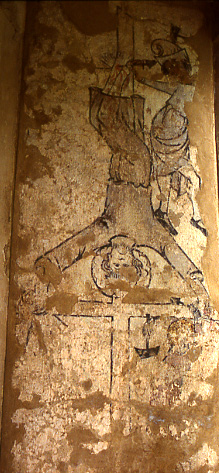Chacombe, Northamptonshire (†Peterborough) C.14
Martyrdom of St Peter

The belief that St Peter was crucified head-downwards is no more than a tradition, but it is a remarkably persistent tradition nevertheless, attested to by no less an authority than Origen.There is one other (forthcoming) example of the subject, at Ickleton in Cambridgeshire, but I know of no others in English wall painting (there is a fine 12th century one at Vic [Indre]), in the Loire Valley in France, although Peter is of course near-ubiquitous in other roles and contexts.
The presentation of the saint on his cross is more or less what we would expect, with logic and gravity defied by the skirt of his robe (a characteristic shared by the Ickleton example) as well as by the apparent mid-air position of the torturer at the upper right. This man has the ‘comedy’ fool’s hat found on many of the torturers of Christ or the saints (as in, for example, the roughly contemporary painting of the Life of St Catherine at Sporle in Norfolk) The torturer’s dark-painted face may also be intended to convey moral depravity, although the darkening of pigments over time makes it impossible to be sure about this.
At the bottom right of the painting are faint traces of another torturer, wielding a hammer (with an odd, irregularly-shaped head) like his companion above, but otherwise a very obscure figure now. The continuation of the upright of the cross “below” (i.e. above) the transverse bar is hard to account for; the impression given is that the painter was uncertain how to present Peter’s upside-down cross, as opposed to his bodily position on it.
The painting is a remarkable survival. It is on a window-splay, the embrasure of which was walled-up, presumably at the Reformation. It was uncovered only in 1982, when the painting, its presence hitherto unsuspected, was found. This accounts for its generally very good condition, as least so far as the central figure is concerned, and it is heartening to report that the large stone slab used to block the window turned out to be an early altar, complete with consecration crosses and the prescribed hole for a relic.
The painting may have been associated with a subsidiary altar, which may in turn have been associated with a 14th-century chantry chapel in the north aisle. And the altar-stone used to block the window has now been restored to its original use.